The Debauchery of Decadence in “New Year’s Eve” by Arthur Symons
© Copyright 2024 Leila Boyachek, Toronto Metropolitan University
Introduction
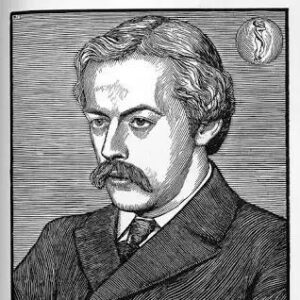
Arthur Symons was born in Milford Haven, Wales, in 1865. He died in Wittersham, England, in 1945. Throughout his 79 years of life, Symons was a poet, critic, and editor. He is most known for his poetry collections and his role as editor of The Savoy. Symons’ poetry often included sensuality, urban life, and spirituality themes. Symons’ poem “New Year’s Eve” is a provocative poem that tells the story of two lovers and their intense feelings that exist beyond the physical world. The people who consumed The Savoy were those who had the wealth to spare money on the arts and had the time to read the magazine. Many of the people who fell into that category had Christian beliefs and found the contents to be scandalous and sacrilegious. Due to the lack of readership, it is not surprising that the magazine did not generate enough revenue to continue to be published. Despite the magazine’s failure, Symons influenced and memorialized the Decadent movement with his own works and the works that he chose to incorporate into The Savoy.
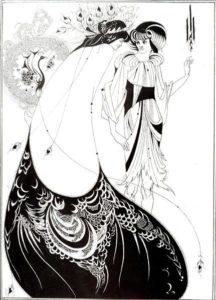
The Decadent Movement
The Decadent movement was popular in French and English literature from 1880 to roughly 1900 but saw its height in the 1890s. This is accredited to the scandalous magazines published throughout the decade that were so infamous that the era was given the moniker Yellow Nineties, named after the yellow covers that bound the magazines. The Decadent movement is characterized by aesthetics, artificiality, and decay (Arata 1008). The word “decadence” means to fall away from vitality into a state of deterioration (Oxford English Dictionary). Arata (1008), describes Decadent literature as a tortoise bejewelled with rare stones that dies due to the weight. For a moment, it is beautiful, but fundamentally it is cruel and grotesque.
Arthur Symons and the Decadent Movement
In 1893, Arthur Symons published the essay “The Decadent Movement in Literature” in Harper’s New Monthly Magazine. In this essay, Symons says “Decadence, Symbolism, Impressionism … [are] the badge of little separate cliques, noisy, brainsick young people … theoriz[e] over the works they cannot write” (“THE DECADENT MOVEMENT” 858). At this time, many active movements in literary spaces claimed to be different from others but ultimately had no major differences. Decadence, Symbolism, and Impressionism fall under the Aestheticism category and share the overarching goal of creating art for pleasure, not God. Prior to the Aesthetic movement, art was created to glorify God and evangelize the masses. Symons goes on to say that the Decadent movement is nothing more than “the newest movement in literature” (“THE DECADENT MOVEMENT” 859). Aestheticism was not an organized movement which explains why new movements stemmed from it. The different movements created off of Aestheticism had more to do with politics than different forms of art. Despite Symons’ frustration with different movements holding the same values, he participates in continuing this phenomenon. Symons distanced himself from the Decadent movement after the trials of Oscar Wilde to save himself from the same social scrutiny. Symons went as far as renaming his celebrated essay to The Symbolist Movement in Literature (Evangelista). Symons describes the Decadent movement as a “spiritual and moral perversity”, a “disease of form” and a reflection of a society that is “over-luxurious, over-inquiring” (“THE DECADENT MOVEMENT” 859). Symons’ essay called out the lack of difference between popular movements of his time and defined what the Decadent movement was. Symons’ influence can be seen in the modern perception of the Decadent movement which includes the hallmarksthat Symons articulated in his essay.
The Oscar Wilde Trials
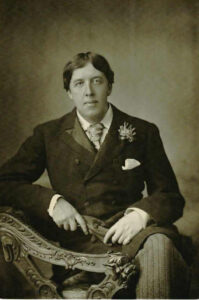
Oscar Wilde is regarded as a key figure in the Decadent movement (Kaplan 113). Wilde was involved in three notable trials in 1895. In the first trial, Wilde attempted to sue the Marquess of Queensbury for accusing him of corrupting young men and writing about two men having sex (Coste 1). Wilde dropped the case and the Marquess was found not guilty (Coste 1). Wilde was placed in custody and subsequently tried for gross indecency and homosexuality after he dropped his lawsuit (Coste 1). The first time he was tried on these charges, the jury was unable to reach a unanimous verdict (Coste 1). Wilde was tried again on the same charges and found guilty (Coste 1). Wilde’s punishment was two years of hard labour (Coste 1). Oscar Wilde’s writing, especially his novel, The Picture of Dorian Gray, was rebuked by the public after his sentencing (Coste 6). Wilde’s close ties to the Decadent movement had writers running away from the literary trend in fear of facing the same fate as he did. Decadence became synonymous with Oscar Wilde and homosexuality in his first trial. The defence of the first trial highlighted values shared by Decadent authors, such as desiring and pursuing pleasure, leisure, and beauty, as evidence of his depravity and inability to function in society (Coste 8). Oscar Wilde’s conviction not only condemned same-sex relationships at a highly publicized level but also displayed how the public believes that literature consumption is a force that is capable of corrupting the mind (Kaplan 130). Without the Oscar Wilde trials taking place, the shift away from the Decadent movement by its contributors, would not have been so distinct.
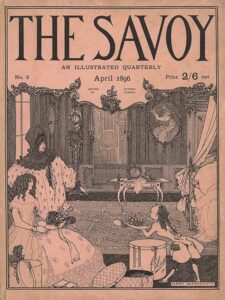
The Savoy
The Savoy, created by Leonard Smithers and edited by Arthur Symons, was one of the magazines published during the Yellow Nineties. Only eight issues of the magazine were published throughout 1896 before it was cancelled due to lack of funds (Keep). During the time of its publication, The Savoy was primarily regarded as eccentric and crude. The artwork in the magazine was created by Aubrey Beardsley, who incorporated intricate linework with Decadent themes. Beardsley’s work received criticism for its explicit nature. Symons’ contributions to The Savoy have preserved the bizarre art of the Yellow Nineties (Daniel 166). In the first edition of The Savoy, Symons proclaims that “We are not Realists, or Romanticists, or Decadents” (“Editorial Note” 5). Although Symons tried to distance himself from the Decadent movement in the wake of the Oscar Wilde trials that occurred just the year before the publication of The Savoy, his written works continued to include elements of Decadence. According to Symons, the first edition of The Savoy was designed with the “belief that good writers and artists will care to see their work in company with the work of good writers and artists” (“Editorial Note” 5). In other words, art for art’s sake, a belief shared by Decadent writers. Despite Symons’ efforts to distance himself from any movement within the first edition of The Savoy, his poetry continued to include Decadent qualities. Daniel argues that The Savoy reflects Symons’ “complete obsession with the decadent” (166). This can be seen in Symons’ poem, “New Year’s Eve.”
“New Year’s Eve” – A Poem
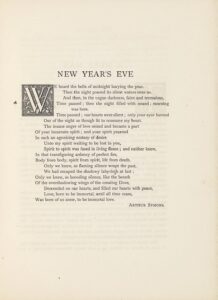
The poem “New Year’s Eve” by Arthur Symons was published in the second edition of The Savoy in April 1896. The poem describes how the love two unnamed people share is so strong that it goes beyond death. Polite society and the religious would have been offended by the sexual and spiritual motifs at the time of publication. This poem is the story of a couple that end their lives together on New Year’s Eve. The first line of the poem, “We heard the bells of midnight burying the year” creates an eerie backdrop to this story. Bells were rung after a person’s death and after a couple was married with the purpose of warding away the devil (Association of Ringing Teachers). The line “Then the night poured its silent waters over us” hints towards the couple drowning together and “ Time paused ; our hearts were silent” further confirms that the couple is dead (lines 2 & 6). The theme of death is common in Decadent works. The image of bodies bloated and decomposing in water is nauseating. Symons describes the couple’s feelings as “insane anger of love” (line 8). This description hints at the couples’ frustration of having to hide their love in fear of facing social ridicule. Insane anger creates connotations of violence and fear, describing love as such is unorthodox. Decadent literature, characterized by Symons, is unhealthy (“THE DECADENT MOVEMENT” 859). The discussion of fire, “Spirit to spirit was fused in living flame,” points to the couple being cleansed of the sins that society believes them to have committed as unwed lovers and they are reborn as pure in the afterlife (line 12). “Love, born to be immortal, until all time cease,” describes how the couple was unable to marry on earth (line 20). The last line, “Was born of us anew, to be immortal love” restores their love in the afterlife and they can be together (line 21). A beautiful image likened to an ugly one is a common theme found in Decadent literature that Symons executes perfectly. The love that the couple shares for each other is rare and precious, but their death corrupts this beautiful vision in a true Decadent fashion.
New Year’s Eve – Holiday
Modern New Year’s Eve parties reflect the overconsumption of our society. Cheap accessories with the new date are adorned for one day, then discarded in the garbage. Confetti and glitter are thrown in the air, only to be abandoned in the street. New clothes created by child labour are purchased for parties and never worn again. All these things create a beautiful facade, but considering the ramifications they will have on the planet, they are a heinous waste. Arthur Symons’ poem “New Year’s Eve” calls attention to the decadent practices intertwined with the celebration of the new year. Symons said, “Decadence reflects all the moods, all the manners, of a sophisticated society” (“THE DECADENT MOVEMENT” 859). The contents of his poem highlight the significant and spiritual sentiments attached to New Year’s Eve. Symons’ choice to name his poem after the lavish holiday points to how he observed society partaking in activities they condemned the rest of the year. Many people participate in superstitions to ward away evil and misfortune. Balls and parties also took place in the 1890s to ring in the new year. These parties included food and desserts, music and dance (The Evening World). Alcohol was not always present, as partygoers battled against prohibition (The Evening World). The values of the Decadent movement are not lost to history. The juxtaposition of beautifully vile imagery can be found in our current way of life. There are many ethical and political considerations needed to create art in the past and in the present.
Works Cited
Arata, Stephen. “DECADENT FORM.” ELH, vol. 81, no. 3, 2014, pp. 1007–27. JSTOR, http://www.jstor.org/stable/24475614. Accessed 19 April 2024.
Association of Ringing Teachers. “History – Discover bellringing.” Bellringing, bellringing.org/discover-bellringing/history-of-bellringing. Accessed 19 April 2024.
Coste, Bénédicte. “Autonomy in the Dock: Oscar Wilde’s First Trial”, Norms and Transgressions in Victorian and Edwardian Times, vol. 79, 2014. OpenEdition, https://doi.org/10.4000/cve.1114. Accessed 18 April 2024.
Daniel, Anne Margaret. “Arthur Symons and The Savoy.” Literary Imagination, vol. 7, no. 2, 2005, pp. 165-193. Oxford Academic, https://doi.org/10.1093/litimag/7.2.165. Accessed 18 April 2024.
Evangelista, Stephano. “Arthur Symons (1865-1945),” Y90s Biographies, 2011. Yellow Nineties 2.0, edited by Lorraine Janzen Kooistra, Ryerson University Centre for Digital Humanities, 2019, https://1890s.ca/symons_bio/.
Kaplan, Morris. “Literature in the Dock: The Trials of Oscar Wilde.” Journal of Law and Society, vol. 31, no. 1, 2004, pp. 113-130. Wiley, https://doi-org.ezproxy.lib.torontomu.ca/10.1111/j.1467-6478.2004.00281.x. Accessed 19 April 2024.
Keep, Christopher. “General Introduction to The Savoy (1896)” Savoy Digital Edition, edited by Christopher Keep and Lorraine Janzen Kooistra, 2018-2020. Yellow Nineties 2.0, Ryerson University Centre for Digital Humanities, 2022, https://1890s.ca/savoy-general-introduction/
Oxford English Dictionary. “Decadent, Adj. and N. Meanings, Etymology and More.” www.oed.com/dictionary/decadent_adj?tab=meaning_and_use#7304639. Accessed 18 April 2024.
Symons, Arthur. “Editorial Note.” The Savoy, vol. 1 January 1896, pp. 5. Savoy Digital Edition, edited by Christopher Keep and Lorraine Janzen Kooistra, 2018-2020. Yellow Nineties 2.0, Ryerson University Centre for Digital Humanities, 2019. https://1890s.ca/savoyv1-symons-editorial/
Symons, Arthur. “New Year’s Eve.” The Savoy, vol. 2, April 1896, p. 25. Savoy Digital Edition, edited by Christopher Keep and Lorraine Janzen Kooistra, 2018-2020. Yellow Nineties 2.0, Ryerson University Centre for Digital Humanities, 2019. https://1890s.ca/savoyv2-symons-new-year/
Symons, Arthur. “THE DECADENT MOVEMENT IN LITERATURE.” Harper’s New Monthly Magazine, vol. 87, 1893, pp. 858- 865. ProQuest, http://ezproxy.lib.torontomu.ca/login?url=https://www.proquest.com/magazines/decadent-movement-literature/docview/1301505077/se-2. Accessed 18 April 2024.
The Evening World. (New York, NY) 1 January 1890, p. 1. Retrieved from the Library of Congress, www.loc.gov/item/sn83030193/1890-01-01/ed-1/. Accessed 19 April 2024.
Images in this online exhibit are either in the public domain or being used under fair dealing for the purpose of research and are provided solely for the purposes of research, private study, or education.
